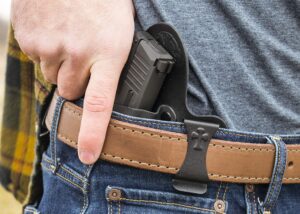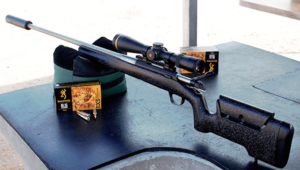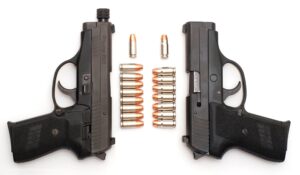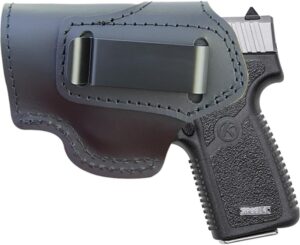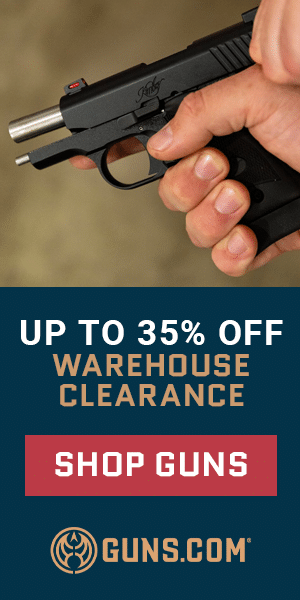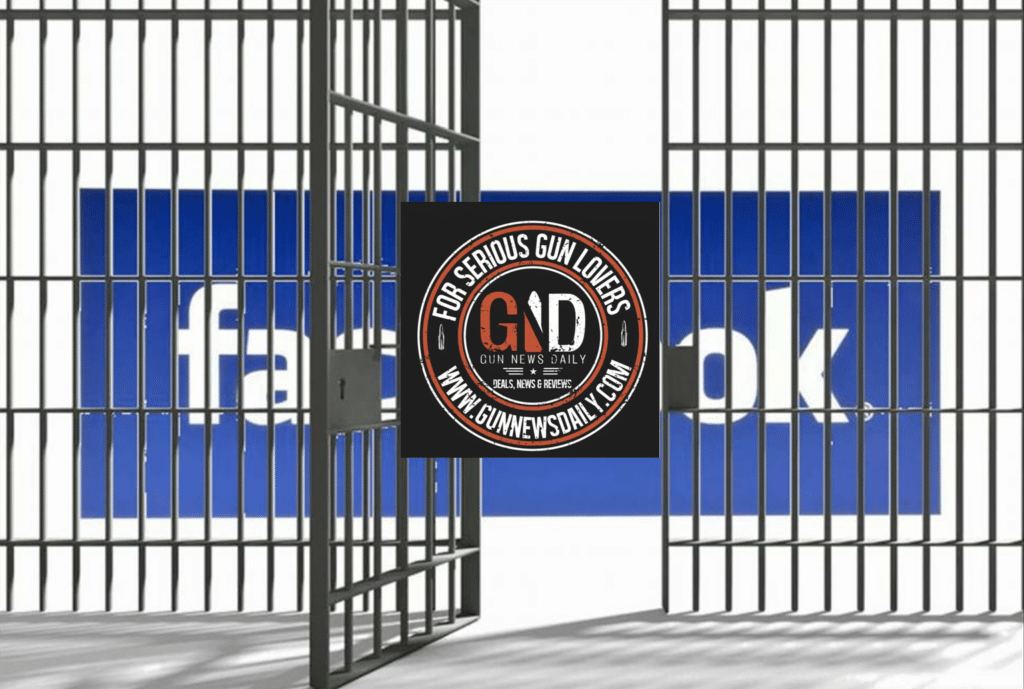Unpack This Article's Arsenal
The recent shooting in a Moscow supermarket by police Major Denis Yevsyukov, who killed three people and wounded six, only added to the negative image of those who are supposed to protect the population from illegal guns used by criminal elements. Yevsyukov used a pistol that had been missing for nine years, and it is now suspected that he and his deputy were engaged in illegal gun trade. The incident has spurred debate over further legalization of gun ownership in Russia, including the right to carry a gun. But this problem is by no means endemic to Russia.
The debate over gun control has been an important issue for both the United States and Russia. An intertwined mesh of legal frameworks and restrictions regulates firearms possession in the United States, and legislation varies at the state and even the local level. The U.S. firearms market is governed by many conflicting interests–the aspirations of gun enthusiasts, the belief in the civil right to bear arms that dates back to 1791, different interpretations of statistics on gun-related crime, the interests of gun control and gun legalization activists, and, of course, the business interests of the gun manufacturers and sellers.
Get Great Guns And Ammo Deals!
SAFEST NEWSLETTER - WE WILL NEVER SELL YOUR EMAIL
No Spam - No Selling Your Email
Taxation is part of the picture as well, along with the authorities’ ability to control gun possession via bans on certain types of firearms, background checks, and licensing. Illegal gun trade is an important issue for the U.S. government due to the country’s proximity to Mexico, where a violent drug war is in full swing. The Russian authorities have similar control issues, including an illegal arms trade frequently perpetrated by the government enforcement agencies.
 Sons of a Gun
Sons of a Gun
Even though the United States is believed to have one of the most liberal gun regimes, firearms sales remain a highly politicized issue, especially after the shootings at Columbine High School in 1999 and at Virginia Tech in 2007. Fully-automatic and semi-automatic firearms are the most regulated categories of weapons. The National Rifle Association (NRA) has been one of the most ardent advocates of gun legalization, and has in fact been criticizing President Barack Obama for threatening the rights of legal gun owners by planning to revive the Federal Assault Weapons Ban (AWB) that was in effect from 1994 to 2004. This ban was signed into law by President Bill Clinton and had prohibited the sale of the so-called “assault weapons” to civilians.
The fear of another ban has driven gun and ammunition prices up, as people have rushed to purchase them since Obama’s election in November. The price of an AK-47 almost doubled between October and December of 2008. In May, president Obama nominated Sonia Sotomayor to the U.S. Supreme Court, which alarmed gun lobists since she has a record of supporting gun control.
In the United States debate also continues on the subject of various interpretations of the Second Amendment to the Constitution. According to a 2008 Gallup survey, a solid majority of the U.S. public (73 percent) believes that the Second Amendment guarantees Americans’ right to own guns. Twenty percent believe that the amendment only guarantees this right to the members of the state militia. Also according to Gallup, in 2008 nearly seven out of ten Americans were opposed to a law prohibiting possession of a handgun.
The diversity of legislation surrounding guns in the United States is a result of the country’s rich firearms history. Guns are an integral part of the American national identity, beginning with the drive of the pioneers to the West and their need to protect themselves and to hunt. Guns acquired further patriotic symbolism during the Revolutionary War, where the threat of British confiscation sparked the “shot heard around the world.” Hollywood flooded the world with images of cowboys and gangsters.
According to the NRA, in 2008 there were over 250 million privately-owned firearms in the United States, 90 million of them handguns. This number is growing by four million every year. There are 70 to 80 million gun owners. For comparison, the U.S. Army has about 489 thousand people on active duty and approximately 189 thousand in reserve—civilian possession of guns in the United States is higher than within government agencies and the military put together.
The Best Policeman Is One with No Gun
Unlike in the United States, the Russian central government has a monopoly on gun legislation along with all other laws. The Soviet Union prohibited civilian gun ownership in 1929. Joseph Stalin has once said: “We don’t let them have ideas. Why would we let them have guns?”
After the collapse of the Soviet Union gun laws became less stringent. Current law divides the individuals who are allowed to own firearms into three categories: regular citizens, military personnel and law enforcement officers. Each category can own only particular types of firearms: civilians are permitted to use firearms for self-defense, hunting, sports shooting and signaling. People looking to buy a gun have to obtain a license from the Interior Ministry, which implies a medical and a criminal record check, as well as completion of a gun safety course.
There are also restrictions concerning keeping and carrying guns around. To hunt, one has to be a member of a hunting club. Certain rules regulate the safe storage of a firearm in the house, but many argue that storing a gun apart from ammunition defeats the purpose of owning a gun for self-defense.
Advocates of further gun legalization in Russia argue that any kind of weapon can be purchased on the black market, and thus the government should allow the general public to defend itself from criminals. Plus, the legalization of weapons would provide for a better control mechanism through licensing and taxation.
Most young men in Russia become familiar with guns either via mandatory military training at school or when drafted into the army. Thus one might say that there is a gun culture in Russia mostly associated with serving in the Russian army – a rather negative experience for most. In contrast, in many parts of America boys are introduced to guns at a younger age as part of the process of maturing and attaining manhood.
In Russia, guns are also associated with a high volume of criminal violence in the 1990s, when gangsters terrorized the civilian population while law enforcement agencies, including the police, stood idly by or even actively collaborated with the criminals. In 2001, three million firearms were registered in Russia, but there are millions of illegal guns being traded on the black market, including guns that have been stolen from or “lost” by military personnel and law enforcement officers. According to a recent investigation by the Russian journalist Sergey Kanev, in the period from 1951 to 2008 about 182 thousand firearms in Russia ended up in this “on the loose” category.
The number of legal gun owners in Russia has increased by at least a factor of ten since Soviet times. The crime rate, however, has stayed the same. Every year, criminals kill some 65 thousand people in Russia. On top of this, many Russians do not trust the police, who are often perceived as part of the criminal world. According to a survey conducted by the Public Opinion Foundation in 2002, 54 percent of those surveyed attributed negative personal and professional characteristics to the police. But these statistics seem modest, as every Russian would admit without hesitation that the police take bribes.
There are independent statistics supporting the claim that gun ownership does not necessarily lead to more crime. The U.S. Department of Justice has found that between 1987 and 1992, offenders armed with handguns committed one in every eight violent crimes – rape, robbery and assault. Other violent crime victims were attacked or threatened by offenders who were either unarmed or armed with rocks, sticks, knives or other types of firearms. Simple assault, the most common violent crime in America, by definition does not involve the use of a weapon. Also, according to the same source, in the states that allow people to carry concealed arms the level of murders is lower by 33 percent, and robberies by 37 percent.
Another aspect of gun ownership in the United States is its meaning within the larger framework of the American democracy and the perception of freedom. As Mao Zedong said, “political power grows out of the barrel of the gun.” The fact that the population is armed indeed implies that the American government does not have a monopoly over cohesive power. The political implications of guns in Russia are different, because on the one hand, the government claims a monopoly over violence; while on the other hand, it seems impaired in the face of illegal arms trade and corruption.
For more Gun News and Information. Please visit https://gunnewsdaily.com




